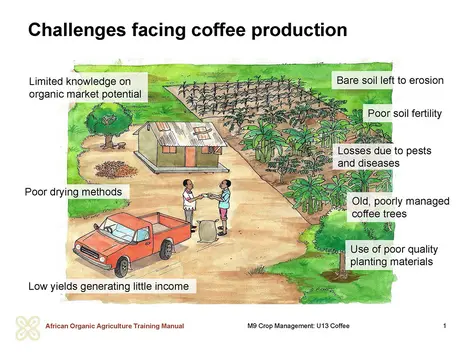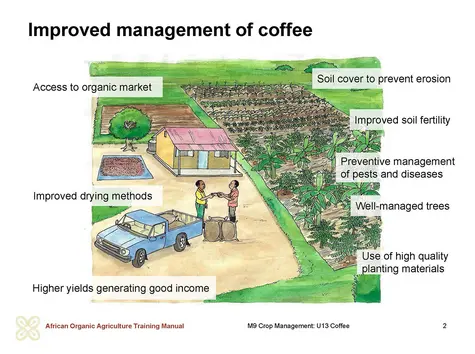Introduction
Coffee is a major commodity on the global market. In Africa the crop is grown in many sub-Saharan countries and mainly by small-holder farmers. Although many species of coffee exist, commercial production is based principally on Coffea arabica and Coffea canephora, commonly referred to respectively as Arabica coffee and Robusta coffee. Arabica coffee grows better at higher altitudes, while Robusta coffee is better suited to warmer, more humid lowland environments.
Common challenges to coffee production in Africa
Coffee production in most major producing African countries is reported to be declining. The decrease in productivity has been attributed to a range of factors, mostly production related, such as:
- Low yields - Most coffee comes from very old and poorly managed coffee gardens with old trees. Since coffee is a perennial crop that can produce coffee beans for many years, most farmers leave it to overgrow and only remember it at the time of harvest. Such old and poorly managed trees usually have reduced production potential.
- Declining soil fertility - Most farmers leave coffee plants to grow naturally and do not give much attention to them. They harvest the coffee every season, but do not add any nutrients essential to soil fertility. Even the coffee husks after pulping in wet processed coffee are taken to plots where annual crops are grown (in dry processed coffee the husks are sold along with the coffee). As a result, soil is continuously mined and its fertility continues to decline.
- Soil erosion - Soil erosion is most common in the Arabica systems at higher altitudes. It is also a problem in Robusta systems on sloping land. Without erosion control measures, running water from uplands washes down the nutrient-packed topsoil into the lowlands. Lack of appropriate erosion control measures encourages soil degradation and decreases productivity.
- Use of poor-quality planting materials - Coffee is normally treated as a side crop and given very little attention. Many farmers use undergrowths from fallen berries under the coffee trees as planting material. This practice negatively affects the quality of the transplanted seedlings and eventually the coffee trees.
- Pest and disease problems - The larvae of the Coffee Berry Borer (Hypothanemus hampei), which feed on the coffee beans, can result in total yield loss. The coffee wilt caused by the fungus Fusarium xylarioides is a major disease threat to the coffee industry in Africa. It has been reported in all major coffee producing countries like Uganda, Democratic Republic of Congo, Tanzania (on Robusta coffee) and Ethiopia (on Arabica coffee).
- Low returns from coffee production - Although most coffee is grown under low input systems; the costs of production are reported to be increasing. The major costs include hiring labour for weeding, general maintenance of gardens, harvesting and postharvest handling. At the same time coffee prices are decreasing. This situation has forced many farmers to abandon their coffee fields for other crops.
- High postharvest losses - When coffee prices increase, many farmers harvest coffee berries prematurely (green or half green) hoping to get more money. Such beans will then be sorted out during milling and grading. Poor handling during drying results in additional losses. In some areas, lack of coffee pulping machines for wet processing lead to more postharvest losses.
- Limited knowledge on organic market potential and certification - The market for organic coffee is reported to be growing, especially in the export markets of Europe, USA and Japan. In order for farmers to benefit from these premium export markets, they need to conform to organic production requirements and certify their systems according to the applicable organic standards.
As a result of the many challenges associated with coffee production, many African coffee farmers are increasingly abandoning coffee for other crops. This situation calls for interventions, making the coffee production more sustainable and profitable for the producing communities. This chapter introduces organic approaches to address coffee production challenges, which can be adapted to the prevailing local conditions.
Discussion: Assessment of the local situation
Inquire about the farmers’ knowledge of coffee production and especially about the common challenges faced in coffee production by asking the following questions:
- Do you experience any of the above or other challenges?
- How have you tried to address them?


 tap and then scroll down to the Add to Home Screen command.
tap and then scroll down to the Add to Home Screen command.